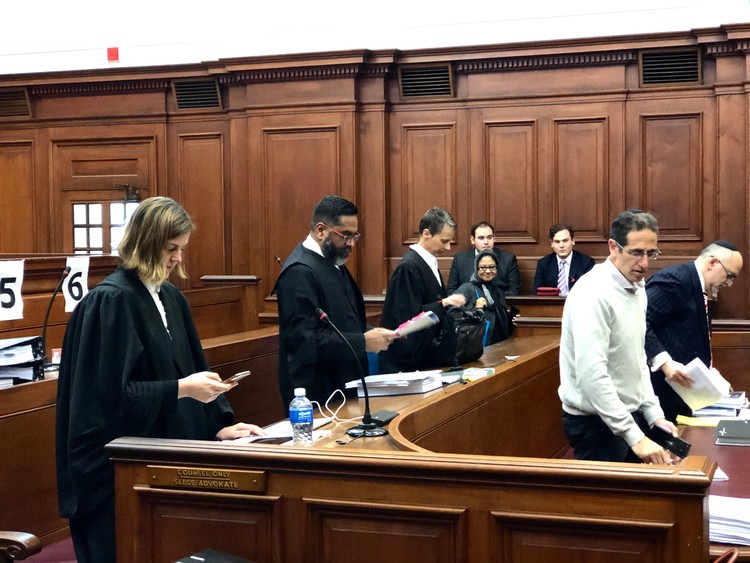
Final arguments and statements took place in the Western Cape High Court on Friday, marking the end of the Tafelberg property case. Photo: Madison Yauger
29 November 2019
The long-awaited Tafelberg case ended on Friday after five days in the Western Cape High Court.
This matter concerns the province’s decision to sell a Sea Point property to a private day school instead of using the property for social housing. Reclaim the City and Ndifuna Ukwazi Law Centre took the province and the City of Cape Town to court to address this. The national Department of Human Settlements launched a separate case against the province for not consulting the national minister prior to making the decision to sell. The matters were heard together this week.
Close to 30 spectators watched intently from the gallery.
Advocate Emma Webber spoke for the Social Housing Regulatory Authority concerning the restructuring zones and the obligation to redress spatial injustice.
She addressed the fact that the Tafelberg property was not in a restructuring zone. The national minister decides restructuring zones across the country. Properties in these zones are eligible for a restructuring capital grant from the national government to, for example, build social housing.
The province has used the fact that Sea Point is not in a restructuring zone to explain its decision not to build social housing on the Tafelberg site. The site wouldn’t be eligible for the restructuring capital grant.
But Webber disputed this reasoning. She said that the problem could have been avoided altogether had the province simply conferred with the national minister.
“It is common cause that Cape Town is a spatially divided city,” said Webber, acknowledging the remaining footprint of apartheid. She said that the central business district (CBD) is only a few square kilometres and yet it accounts for 30% of the city’s workforce. She said in terms of spatial injustice, there’s no questioning the need to address housing around the city centre.
“It’s always going to be more expensive to build housing in well-located areas than on the outskirts, but that is what is entailed in this obligation (to address spatial apartheid),” Webber said. “If it’s always cheaper to build on the outskirts, this obligation will never be fulfilled.”
Finally, advocate Pete Hathorn stood up to make closing arguments for Reclaim the City and Ndifuna Ukwazi Law Centre.
Hathorn stated that the price of well-located land and housing is the driving force behind ongoing spatial injustice. “Cape Town is one of the most spatially divided cities in the country separated by race and class.” He said urban regeneration has tended to force low-income earners out of the centre of the city.
“Cape Town still very much resembles the make-up of the city in the 1970s. It is less diverse and more segregated now than it was 50 years ago,” Hathorn said. “The applicants’ rights and the state’s obligations are two sides of the same coin. The state needs to implement a reasonable housing program in central Cape Town.”
He further argued the point of land scarcity in the city. Citing the school’s argument that it could not find another property, Hathorn emphasised the need to utilise the land that’s left. He said the province was “patting themselves on the back” for selling off one of these remaining properties without due consideration for the long-term obligations to transform the city. He called the decision “blindingly short-sighted”.
Hathorn cited a 2011 census that noted 47% of households have a monthly income of less than R3,200. 14% make between R3,201 and R6,400 monthly, 13% between R6,401 and R13,000, 12% between R13,001 and R26,000, and 14% make more than R26,000 monthly.
He then read a section of an affidavit submitted by a former Sea Point resident who has experienced apparent hardships since being forced to move out of the city. “To suggest that someone in this capacity is not deserving of relief of affordable housing is to disregard the hardships she has faced.”
Hathorn responded to the City’s argument that it’s unfair to say they’ve done nothing in 25 years. The City had argued that the Social Housing Act only came into effect in 2009 and SPLUMA, or the Spatial Planning and Land Use Management Act came into effect in 2015. Hathorn noted that this suggests that the obligation only became apparent in 2009, which was not the case pleaded by the City and province who both acknowledged an ongoing obligation to redress spatial injustice, he said.
Advocate Coriaan De Villiers concluded the applicants’ argument and spoke about the restructuring zones. The declaratory relief sought by the applicants is that Sea Point falls within the restructuring zone. She said the notices published in 2011 and 2017 are the designations for restructuring zones that the entire social housing program relied on and one cannot question these zones for the sake of argument in this case.
“You’ve given us lots to think about, it’s going to take time,” said Judge Patrick Gamble. “The normal time period is about three-months, but that target is overtaken in this matter. Due to the nature of the papers, May or June is earliest indication for a decision.”
“This matter has huge ramifications. We would like to encourage the legal representatives and parties not to lose sight that this case has a long way to go. We encourage the parties to engage with each other as much as possible to see if there’s any aspect that can be resolved together.”